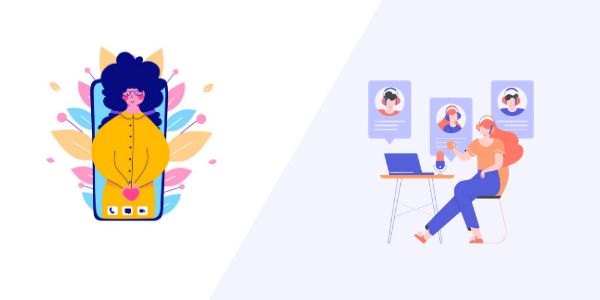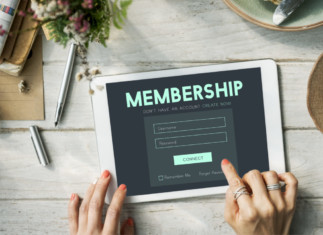Today’s EAPs are not what they used to be and continue to be underutilized due to stigma, confidentiality issues, limited sessions available, wait times, and the arrival of digital technology. Digital therapeutics is a growing market, with the percentage of consumers using mobile health apps tripling over four years, from 16 percent in 2014 to 48 percent in 2018. Employers are now working to onboard digital solutions to safeguard their employees’ mental health in times of COVID-19 and beyond.
It can be confusing for leaders to determine how to expand their employee wellness and mental health programs so we thought it would help to provide insights into the inner workings of EAPs and digital mental health solutions.
What is digital mental health?
Digital mental health is an evidence-based therapeutic intervention driven by expert systems to prevent, manage, or treat a medical or mental health condition. Digital mental health often employs strategies rooted in cognitive behavioral therapy as it’s the gold-standard for mental healthcare. In today’s workplace, employees often need a more convenient yet personalized solution to deal with their mental and emotional struggles.
What is an EAP?
An employee assistance program (sometimes referred to as an EAP/EFAP), is an employee benefit program that assists employees with personal, family, and work issues. The purpose of EAPs is to minimize the impact these problems can have on an employee’s job performance, health, mental and emotional wellbeing. EAPs are cost-effective, and a quality program will offer services to members, their spouse or domestic partner, their parents, and their children.
How does it work?
Digital Mental Health: Depending on the digital mental health solution, it can be purchased by an organization, insurance provider, or other third-parties looking to scale up mental health resources unavailable in the EAP model. Digital mental health relies on the cognitive behavioral therapy method. It focuses on the idea of improving an employee’s behavioral and thought patterns through regular guidance. Solutions like Starling Minds deliver a highly personalized and contextual support approach through an expert system that uses rules and algorithms that mirror the processes and systems that human psychologists use to assess the conditions and symptoms and then tailor treatment to meet their specific needs. As an employee completes their mental health assessments, personality profiles, training exercises, and questions, the program adapts to make recommendations and insights most beneficial to the employee.
EAPs: EAPs generally offer cost-effective and confidential assessments, short-term counselling, referrals, and follow-up services for employees. EAP counsellors would first identify an employees’ struggles during voluntary call-ins and will refer them to a specialist depending on their problems. Depending on the referral type, EAP counsellors may work in a consultative role with managers and supervisors to address the employee’s needs and goals. Reporting may be available through EAPs with total services provided and types of problems addressed during quarterly or annual reviews.
Is it confidential?
Digital Mental Health: Privacy is the cornerstone of digital mental health and addresses one of the biggest barriers as to why employees do not seek help or use their EAP benefits. Often, counsellors and specialists are on-site at a workplace to provide immediate support. However, they are often not utilized enough. Employees are worried that their colleagues may see them, or their information will make its way to their employer, jeopardizing their career and reputation. This is one of the reasons why digital mental health solutions are rising to the forefront of mental and behavioral health. Digital mental health solutions adhere to the same Privacy Act and HIPPA regulations as EAPs; however, leading digital mental health solutions have access to aggregated data to deliver insights to help employers drive better policies and decisions around employee wellbeing.
EAPs: Employers do not get to know who is utilizing the service, what the reasons are for, or how often employees call. Due to the Privacy Act in Canada and Health Insurance Portability and Accountability Act (or HIPPA) regulations in the US, there is complete confidentiality between the third-party EAP provider and the employee. Privacy and confidentiality issues are one of the main reasons why employees do not use their EAP benefits. That is unfortunate as they are more likely to seek help when they feel they can trust the source and have confidentiality. Due to therapists/specialists adhering to Privacy and Confidentiality regulations, EAPs aren’t able to receive as much information or insights to drive smarter policies and decisions.
What types of features and services are offered?
Digital mental health: Digital mental health solutions deliver support digitally via desktop or mobile with technology to help define the nature of the employee’s problem and tailor the treatment to those stressors. The employee would need wifi to view the platform’s modules, videos, and interactive exercises. Digital mental health solutions like Starling Minds include:
- Clinical Assessments: To identify primary mental health conditions with industry-standard assessments
- Dashboard: To show employees their current levels of energy, resilience, anxiety, and depression from check-up questions
- 24/7 CBT training: Delivers CBT to help employees build the skills, tools and strategies they need to manage their mental health better
- Peer Support Community: A confidential peer community to deepen the social and emotional support they’ll need throughout their journey
- Skills Toolbox: Standard homework and exercises to help you set realistic goals, track your progress, balance negative thoughts, and regulate your moods
- Check-up Results & Reports: Allows you to track your assessment scores and share your results and progress with your therapist
- Simple referral process: For case managers to refer claimants to support
- Case manager reporting: To help regain transparency on claimant files regarding treatment adherence and progress
- Enterprise reporting: To identify overall program health through key reporting areas including adoption rates, engagement, and top stressors
Digital mental health solutions can have a service component to it. At Starling, each client is assigned a customer success team member to help organizations demystify mental health for leaders, managers, and employees through workshops. Our Customer Success team also helps organizations launch, adopt, implement, and manage their programs together as strategic partners. Although we are a digital platform, our therapy team monitors and escalates any self-harm members at risk to the appropriate parties and authorities.
EAPs: EAPs deliver counselling support through online resources (internet-based), e-counselling (email), video counselling (webcam, secure internet software), traditional (face-to-face), and live chat (landline or texts) to cover a range of user types and preferences. The range of areas typically managed by an EAP provider includes personal wellbeing, relationship issues, family issues, workplace challenges, substance abuse, financial or legal, and aggregated reporting for the total employee population.
What reporting is included?
Many employers report dissatisfaction with reports from their EAP system and need to reformat them for internal use. Most often, EAP reports are merely operational metrics, providing little value to the employer and offering little insight into the value or outcomes of the program.
For digital mental health solutions like Starling Minds, reporting can be customized and segmented by unit groups to help leaders develop better employee wellbeing policies and practices. It includes:
- Adoption
- Engagement
- Usage
- Demographics
- ROI
- Trends
- F2F engagement comparison
- Interests
- Mental Health Pulse
- Top Stressors
For EAPs, reporting includes:
- Adoption
- Engagement
- Usage
- Demographics
- ROI
- Trends
What are the differences between Digital Mental Health and EAPs?
The chart illustrates the differences between digital mental health and EAPs. Use this chart to evaluate EAPs and determine if a digital mental health platform can be added to enhance workforce mental health offerings for greater value.
| Digital mental health | EAPs | |||||
| Delivery | Online, Digital | Face-to-Face, Teletherapy, Online Resources | ||||
| # of Sessions | Unlimited | 2 to 3 | ||||
| Stigma | Low | High | ||||
| Comprehensive | Prevention, Early Intervention, Return-to-Health | Early Intervention, Return-to-Health | ||||
| EAP Wait Times | Immediate | Immediate | ||||
| Therapist Wait Times | Immediate | Weeks/Months | ||||
| Confidential | ✓ | ✓ | ||||
| User Engagement | Between 10% – 40% | Average 10% | ||||
| Costs | Low | Low | ||||
| Services | Trusted services for program onboarding, implementation, and engagement | Training on EAP products | ||||
| ROI | At least 5:1 | 3:1 | ||||
| Preventative | ✓ | ✕ | ||||
| Employee Satisfaction | 77% | 39% | ||||
| Employee Values | 81% | 60% | ||||
| Effectiveness | 91% | 73% |
What are the pros and cons of Digital Mental Health and EAPs?
Digital Mental Health Pros
- Accessible: Employees also have 24/7, immediate access to digital mental health anywhere and at any time, without needing to wait for an appointment with a mental health professional or limited by sessions within their EAP benefits plan.
- Affordable: Unlike EAPs with capped or limited sessions, digital solutions offer unlimited sessions so employees wouldn’t need to pay out-of-pocket expenses
- Scalable: Due to the delivery model of digital solutions, it would be easy for employers to scale up mental health support without the need to acquire a network of highly-qualified mental health professionals
- Personalized: Personalization will be the new norm in digital interventions, but the strength and efficacy will range depending on the digital mental health solution. For Starling Minds, our expert system mirrors the same practices human psychologists use to deliver the right treatment path for each employee, but without the wait times or inconvenience of on-site/in-person appointments.
- Confidentiality: 100% digital mental health solutions like Starling Minds adhere to the same Privacy Act and HIPPA regulations as EAPs. Other than usernames and email addresses, solutions like Starling do not collect any personal information about employees. Employees are given an anonymous ID number so they can feel more comfortable interacting with the platform. Starling also provides aggregate reporting without identifying information to the employer.
- Reporting: With expert systems in the backend, digital solutions can analyze aggregate data from employees without imposing on their privacy. This will allow employers to truly see a real, accurate picture of their employees’ mental health. This will help drive smarter policies and decisions for workplace mental health.
Digital Mental Health Cons
- Focused, not comprehensive: Digital mental health solutions include treatment for a wide range of physical and mental diagnoses. For Starling, our CBT platform focuses on treating work-related stress, anxiety, and depression. It is appropriate for employers who are looking to proactively help employees manage their mental health or build their mental resilience and coping abilities while on-leave. Starling offers a host of services to help employers launch and increase platform adoption, manage programs, and gain insights into benchmarking and ROI for strategic planning purposes.
- Tech-savvy: Although user experience experts work to create a simple, seamless experience, employees who aren’t comfortable with technology will be less inclined to try digital mental healthcare.
EAP Pros
- Accessible: Employees have direct and immediate 24/7 access to the EAPs and its professional providers, which can be maintained off-site.
- Personalized: Therapists/Specialists within the EAP network would tailor their support to each unique employee.
- Confidentiality: EAPs adhere to the Privacy Act and HIPPA regulations.
- General reporting: The employer never knows who uses the EAPs. The EAP service will provide either monthly, quarterly, or semi-annually aggregate utilization reports with no identifying information to the employer.
- Comprehensive: EAPs services include a wide range of offerings including health and safety, financial and legal, work-related issues, and relationship and family matters support.
- ROI: The typical return on investment (ROI) of an EAP is $3 or more, for every $1 dollar invested, according to the Employee Assistance Trade Association. EAPs can reap savings for employers: lower healthcare costs, fewer disability claims, less absenteeism, higher productivity and focus, improved employee morale, fewer workplace accidents, higher retention (saves the cost of hiring and training a replacement)
EAP Cons
- Stigmatized: Due to the history of EAPs, the programs are largely stigmatized. Employees are concerned about their employers finding out private information that can jeopardize their career and reputation at work.
- Not scalable: EAPs traditionally operate by onboarding a network of mental health professionals to support employees needing help. However, therapist shortages are a chronic issue and an expensive option and therefore not scalable.
- Wait Times: There is usually no wait to see an EAP counsellor, however for an appointment with a mental health professional/any specialist, it can take weeks or even months.
- Limited Sessions: Most EAPs have 24/7 access at virtually no-cost, although there are limitations in sessions available to keep costs low.
- Out-of-Network: Often, employees grow frustrated with their EAPs as their preferred therapist/specialist may be outside of their network, and if they have a poor experience with one therapist, it will turn them off of getting help mental health support in general.
- Reporting: Due to the privacy and confidentiality regulations therapist/psychologists need to adhere to, EAPs would not get a comprehensive picture of what’s happening with their employees beyond general operational metrics (i.e. usage, general employee symptoms).
- Limited mental health support: EAPs typically have limited focus on mental health or in-depth treatment options even the cost of face-to-face therapy sessions, although EAPs are looking to digital mental health solutions to scale up support
Last thoughts
Digital mental health technology is becoming more popular as workplaces navigate the new normal that COVID-19 has created. Leaders are starting to realize digital mental healthcare and its potential, especially with an evolving workforce resulting from the retirement of Baby Boomers, who – although the fastest-growing group of online users – are still not doing so at the rates of the younger generation. As younger generations dominate the workforce, technology will become an even more viable resource for supporting mental health and wellness.
The convenience, flexibility, and affordability of digital mental health solutions will drive higher usage and adoption rates than the traditional interventions offered by EAPs. For employers, it means happier, more productive employees.
As digital mental health solutions evolve to be an even more relevant option for employees, employers and providers, it is important to note that treatment needs to remain personal; what may work for one person may not work as well for another. How employees wish to access services – online, in-person or a combination of the two – is up to the individual.




